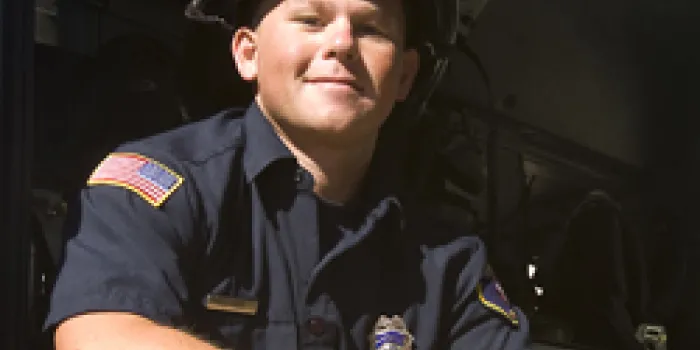Read about Haight's stepson's diagnosis and learn more about mild hemophilia.
HemAware “Takes 5” with people in the bleeding disorders community and spotlights their efforts with just five questions. Here, we talk with Russ Haight, a firefighter, paramedic and nursing student in San Diego, whose teenage stepson was diagnosed this year with mild hemophilia B. Haight created a mnemonic, or memory aid, that spells the word “blood” to help healthcare providers identify people with undiagnosed bleeding disorders.
How did you get involved with the bleeding disorders community?
My stepson Dustin, who’s 14, had his wisdom teeth pulled earlier this year. The first night he had some bleeding, and I was a little bit surprised, although I know there’s some amount of bleeding when you have all four wisdom teeth pulled. I handled it with heavy packing, and the next day we took him to the oral surgeon, who repacked it. But the bleeding continued to the point where my wife actually took him to the emergency room a couple days after his teeth were pulled. They evaluated him, but even with initial lab tests that were pointing toward hemophilia and uncontrolled bleeding, they still discharged him back to the oral surgeon to have him repack his mouth again.
Out of curiosity, I asked my wife if she would print out his labs so I could look at them when I got off work the next morning. Other than mild anemia, the only unusual lab result was a test that reflected his ability to form a clot, the aPTT, which was abnormally prolonged. I took him back to the ER and said, “He’s lost about two liters of blood now, and we think he has a bleeding disorder.” He was diagnosed with hemophilia the next day—he has 5% of the factor he needs. After five or six days of bleeding, the second he was administered the factor, he immediately stopped.
Dustin was in the hospital for three weeks to manage the factor administration and some of the complications of anemia—he lost about half his blood volume. In that time, I started researching hemophilia and tried to figure out why the original ER healthcare providers missed it. I felt compelled to go out and advocate for the bleeding disorders community—particularly the undiagnosed bleeding disorders community—to the healthcare community. I have a link as a paramedic, and I’ll be a nurse next year.
Why did you create the BLOOD mnemonic?
My goal is to create some sort of multimedia presentation based on the BLOOD mnemonic and have healthcare providers use it as part of their differential diagnosis. What I really want to do is to have something to pass around the healthcare community—to ER physicians, oral surgeons, gynecologists, sports medicine doctors, general practitioners—who are likely to see these insidious or prolonged complications of somebody unknowingly suffering from a bleeding disorder.
Explain how the BLOOD mnemonic works.
The mnemonic can be used as a tool when a healthcare provider sees blood or signs of abnormal bleeding to consider hemophilia or von Willebrand disease as a possible cause.
B is for bleeding. Delayed start and intermittent or prolonged bleeding are common genetic bleeding disorder patterns.
L stands for labs. The hallmark of a number of genetic bleeding disorders, and hemophilia in particular, is a prolonged PTT (clotting time) with otherwise normal blood tests. The PTT is commonly correctable with a mixing study. In both instances, a quantitative assay of the factor level is required for definitive diagnosis. If you have a prolonged PTT with otherwise normal blood tests, hemophilia is most likely ruled out, though other bleeding disorders are still possible.
O is for oral. Cases of mild or moderate hemophilia and type 1 or 2 von Willebrand disease can present after tooth extraction with bleeding complications.
O is for ortho. Presentation with red, swollen joint pain is common for people with severe hemophilia and type 3 von Willebrand disease.
D is for deviations. The patient’s age of onset, gender, lack of family history, history of uncomplicated surgeries or circumcision may not rule out a possible diagnosis. Some cases of von Willebrand disease will have normal initial coagulation tests but, based on symptoms, may warrant further lab diagnostics.
What made you decide to focus on the healthcare providers?
Having been a firefighter/paramedic for eight years as well as being in the baccalaureate nursing program at San Diego State, I have a unique opportunity to speak the language to the healthcare providers. I can be a link between the bleeding disorders community and the healthcare provider community. Part of my degree is a minor in communication, and healthcare provider communication between the patient and the physician or nurse practitioner is an important focus for me.
What are you working on next?
I’m submitting a manuscript to the American Journal of Nursing. I’m promoting a pilot screening program on my university campus based on the proposed Congressional bill HR 4846 that’s in subcommittee review. My goal is to use this mnemonic in conjunction with a questionnaire for people with bleeding disorders to screen our students. I want to use that data to determine the efficacy of a program. If warranted, I would then promote a statewide or national program in which student health service programs can include standardized questions that may identify a possible bleeding disorder. It’s equally important that these programs are given the resources to follow up with laboratory tests if needed.
I submitted a resolution to our preprofessional organization, the California Nursing Students’ Association. It says we want to promote a screening program in all of our colleges in California and use the BLOOD mnemonic in all the student health services branches. We have about 146 colleges in the state.
I hope that someday we can have a greater awareness among healthcare providers and make sure no one suffers from one of these diseases without a diagnosis and the care they need.
[Steps for Living: Engaging School Faculty and Staff]

